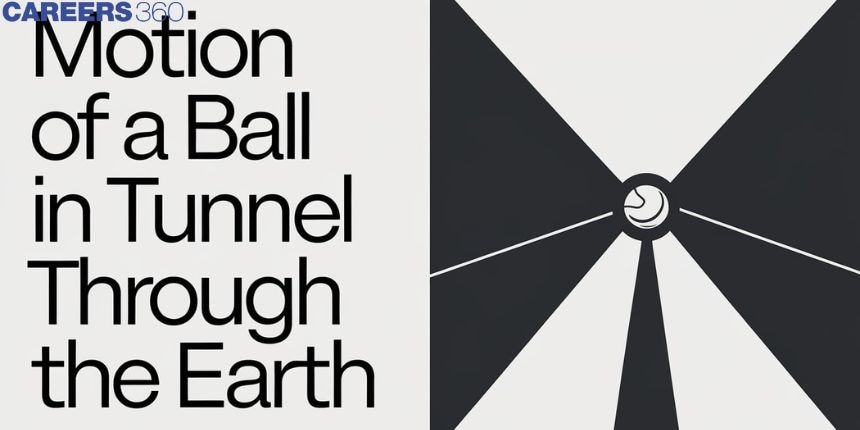Motion Of A Ball In Tunnel Through The Earth
Imagine a scenario where a tunnel is dug straight through the centre of the Earth, connecting two opposite points on its surface. If a ball is dropped into this tunnel, it will experience a unique and fascinating motion. As it falls, the ball would be pulled by Earth's gravity, accelerating towards the centre. However, once it passes the centre, the gravitational force would start decelerating it, eventually bringing it to a halt on the other side. This oscillatory motion can be likened to a pendulum swinging back and forth or a child on a swing moving to and fro. Just as the child or the pendulum always returns to the centre, the ball in the tunnel would keep oscillating around the Earth's core, illustrating fundamental concepts of physics such as gravitational force, potential energy, and harmonic motion. This thought experiment isn't just a whimsical idea; it connects with real-world concepts like simple harmonic motion and gravity, which play a significant role in everything from how we design roller coasters to how we understand planetary orbits.

Motion of A Ball In Tunnel Through the Earth
Imagine digging a tunnel straight through the Earth from one side to the other and then dropping a ball into it. As the ball falls, it’s pulled by Earth's gravity towards the centre. At first, it accelerates, moving faster and faster as it gets closer to the core. But as it passes the centre, something interesting happens the gravitational pull starts to slow it down, eventually bringing it to a stop at the other end of the tunnel. Then, it would start falling back again, creating a repetitive back-and-forth motion, similar to the swinging of a pendulum.
Case I:
If the tunnel is along a diameter and the ball is released from the surface. If the ball at any time is at a distance y from the center of the earth as shown in the below figure,

So the restoring force will act on the ball due to gravitation between the ball and the earth.
Acceleration of the particle at the distance y from the centre of the earth is given by
Case II:
If the tunnel is along a chord and the ball is released from the surface. If the ball at any time is at a distance x from the
centre of the tunnel, as shown in the below figure

then the acceleration of the particle at a distance y from the centre of the earth
and using
This acceleration will be towards the centre of the earth.
So the component of acceleration towards the center of the tunnel.
Note: The time period of oscillation is the same in both cases whether the tunnel is along a diameter or along the chord.
Recommended Topic Video
Solved Examples Based on Motion of a Ball in Tunnel Through the Earth
Example 1: The mass and diameter of a planet are twice those of Earth. The period of oscillation of the pendulum on this planet will be (If its second's pendulum on earth)
1)
2)
3) 2 s
4)
Solution:
The Time period of a ball through a tunnel in the earth
wherein
As we know
Given
and
Also,
Hence, the answer is the option (2).
Example 2: If a body is released into a tunnel dug across the diameter of the earth, it executes simple harmonic motion with time period
1)
2)
3)
4)
Solution:
The Time period of a ball through the tunnel in the earth
wherein
Hence, the answer is the option (1).
Example 3: A ball is released from the surface of the earth along a tunnel such that the tunnel is along the diameter of the earth, then the motion of this ball will have time period equal to T1 and if another ball of twice the mass of the ball in the first case is released along any of the chord of the earth and its motion is having a time period of T2. Then which of the given relations will be true?
1)
2)
3) Can not say as the distance of the chord is not given from the centre of the earth.
4)
Solution:
Case-1. When the tunnel is along a diameter and the ball is released from the surface, then the time period of motion,
Case 2. When the tunnel is along a chord and the ball is released from the surface, then the time period of motion
The time period of oscillation is the same in both cases whether the tunnel is along the diameter or along the chord. It does not depend on the mass. So,
Hence, the answer is the option (2).
Example 4: Assume that the earth is a solid sphere of uniform density and a tunnel is dug along its diameter throughout the earth. It is found that when a particle is released in this tunnel, it executes a simple harmonic motion. The mass of the particle is 100 g. The time period of the motion of the particle will be (approximately) ( Take
1) 12 hours
2) 1 hour 40 minutes
3) 24 hours
4) 1 hour 24 minutes
Solution:
Inside Earth, force is given by
And
Hence, the answer is the option (4).
Summary
The motion of a ball in a tunnel through the Earth can be understood as a form of simple harmonic motion, driven by gravitational forces. Whether the tunnel is along the Earth's diameter or along a chord, the ball oscillates back and forth within the same time period, which is independent of the ball's mass. This concept highlights the uniformity of gravitational effects and the principles of harmonic motion, demonstrating how they apply even in such extreme theoretical scenarios.